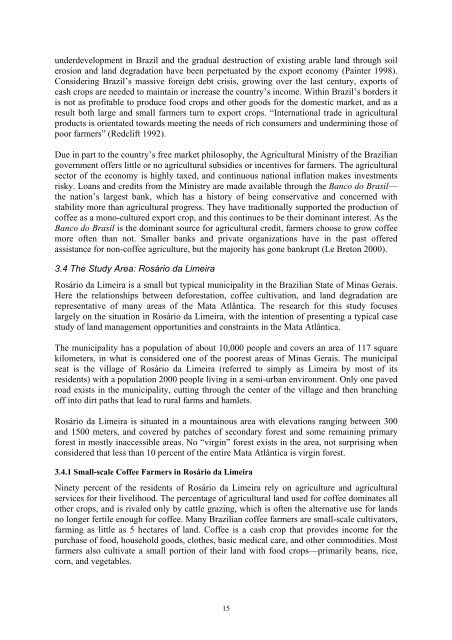Deforestation, Coffee Cultivation, and Land Degradation ... - lumes
Deforestation, Coffee Cultivation, and Land Degradation ... - lumes
Deforestation, Coffee Cultivation, and Land Degradation ... - lumes
Create successful ePaper yourself
Turn your PDF publications into a flip-book with our unique Google optimized e-Paper software.
underdevelopment in Brazil <strong>and</strong> the gradual destruction of existing arable l<strong>and</strong> through soilerosion <strong>and</strong> l<strong>and</strong> degradation have been perpetuated by the export economy (Painter 1998).Considering Brazil’s massive foreign debt crisis, growing over the last century, exports ofcash crops are needed to maintain or increase the country’s income. Within Brazil’s borders itis not as profitable to produce food crops <strong>and</strong> other goods for the domestic market, <strong>and</strong> as aresult both large <strong>and</strong> small farmers turn to export crops. “International trade in agriculturalproducts is orientated towards meeting the needs of rich consumers <strong>and</strong> undermining those ofpoor farmers” (Redclift 1992).Due in part to the country’s free market philosophy, the Agricultural Ministry of the Braziliangovernment offers little or no agricultural subsidies or incentives for farmers. The agriculturalsector of the economy is highly taxed, <strong>and</strong> continuous national inflation makes investmentsrisky. Loans <strong>and</strong> credits from the Ministry are made available through the Banco do Brasil—the nation’s largest bank, which has a history of being conservative <strong>and</strong> concerned withstability more than agricultural progress. They have traditionally supported the production ofcoffee as a mono-cultured export crop, <strong>and</strong> this continues to be their dominant interest. As theBanco do Brasil is the dominant source for agricultural credit, farmers choose to grow coffeemore often than not. Smaller banks <strong>and</strong> private organizations have in the past offeredassistance for non-coffee agriculture, but the majority has gone bankrupt (Le Breton 2000).3.4 The Study Area: Rosário da LimeiraRosário da Limeira is a small but typical municipality in the Brazilian State of Minas Gerais.Here the relationships between deforestation, coffee cultivation, <strong>and</strong> l<strong>and</strong> degradation arerepresentative of many areas of the Mata Atlântica. The research for this study focuseslargely on the situation in Rosário da Limeira, with the intention of presenting a typical casestudy of l<strong>and</strong> management opportunities <strong>and</strong> constraints in the Mata Atlântica.The municipality has a population of about 10,000 people <strong>and</strong> covers an area of 117 squarekilometers, in what is considered one of the poorest areas of Minas Gerais. The municipalseat is the village of Rosário da Limeira (referred to simply as Limeira by most of itsresidents) with a population 2000 people living in a semi-urban environment. Only one pavedroad exists in the municipality, cutting through the center of the village <strong>and</strong> then branchingoff into dirt paths that lead to rural farms <strong>and</strong> hamlets.Rosário da Limeira is situated in a mountainous area with elevations ranging between 300<strong>and</strong> 1500 meters, <strong>and</strong> covered by patches of secondary forest <strong>and</strong> some remaining primaryforest in mostly inaccessible areas. No “virgin” forest exists in the area, not surprising whenconsidered that less than 10 percent of the entire Mata Atlântica is virgin forest.3.4.1 Small-scale <strong>Coffee</strong> Farmers in Rosário da LimeiraNinety percent of the residents of Rosário da Limeira rely on agriculture <strong>and</strong> agriculturalservices for their livelihood. The percentage of agricultural l<strong>and</strong> used for coffee dominates allother crops, <strong>and</strong> is rivaled only by cattle grazing, which is often the alternative use for l<strong>and</strong>sno longer fertile enough for coffee. Many Brazilian coffee farmers are small-scale cultivators,farming as little as 5 hectares of l<strong>and</strong>. <strong>Coffee</strong> is a cash crop that provides income for thepurchase of food, household goods, clothes, basic medical care, <strong>and</strong> other commodities. Mostfarmers also cultivate a small portion of their l<strong>and</strong> with food crops—primarily beans, rice,corn, <strong>and</strong> vegetables.15
















